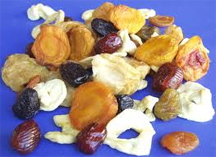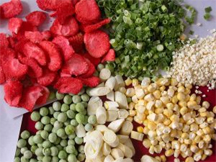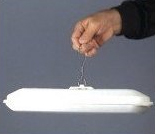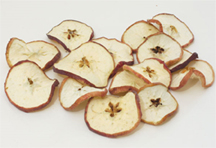Getting Prepared: Learning
To Dry Fruits and Veggies
By Alice Osborne
 Food Dehydration is the oldest form of food preservation. In the beginning, people used a lot of salt to preserve foods, and they dried their food in the sun or in ovens. Today we have the food dehydrator which frees up the oven and increases the drying efficiency.
Food Dehydration is the oldest form of food preservation. In the beginning, people used a lot of salt to preserve foods, and they dried their food in the sun or in ovens. Today we have the food dehydrator which frees up the oven and increases the drying efficiency.
Food dehydration is safe because water is removed from the food. Because water is removed from the food, mold and bacteria cannot grow on it; thus it will not spoil. There is, however, some loss of vitamin A and C in dried foods due to heat and air. It usually takes vegetables 6-16 hours to dry, and fruit 12-48 hours.
 One of the very attractive things about dehydrating fruits and vegetables is that they don’t need sugar for preservation. Those of us with blood sugar issues are especially happy about this.
One of the very attractive things about dehydrating fruits and vegetables is that they don’t need sugar for preservation. Those of us with blood sugar issues are especially happy about this.
There is a ton of information on the Internet on how to successfully dry our own food, as well as oodles of how-to/cookbooks written on the subject. It’s not a difficult process and compared to water bath canning, is less time- and labor-intensive. Vegetables need blanching before drying to stop enzyme action and enhance destruction of micro-organisms, however. One of the things I wondered about was which dehydrator is the best. As I was comparing brands and models (again, on the Internet), I stumbled across a solar dehydrator invented by Duane Erickson, of Evanston, Wyoming. This is exciting to me because along with preserving my food, I want to be more energy independent, and dehydrating using the sun seems like a smart idea.
 This product is reasonably priced (around $60) compared to the electric models (around $200), and it collapses (see photo) for easy storing. I like this idea as well, as the solar dehydrators I’ve found on the Internet are of the wooden box-type that set on legs out in the yard — tough to store during the off-season. Duane’s dehydrator can be hung — also a good idea.
This product is reasonably priced (around $60) compared to the electric models (around $200), and it collapses (see photo) for easy storing. I like this idea as well, as the solar dehydrators I’ve found on the Internet are of the wooden box-type that set on legs out in the yard — tough to store during the off-season. Duane’s dehydrator can be hung — also a good idea.

 Reviewers say they like the product so much that they are ordering duplicates. I contacted the inventor directly (you can too: derickson1@allwest.net) and he is more than happy to sell me one, so I can avoid the middle man and save a little money. What was extra exciting and totally unexpected is that Duane is willing to come to my home and teach a general class on how to dehydrate and then how to use his product!
Reviewers say they like the product so much that they are ordering duplicates. I contacted the inventor directly (you can too: derickson1@allwest.net) and he is more than happy to sell me one, so I can avoid the middle man and save a little money. What was extra exciting and totally unexpected is that Duane is willing to come to my home and teach a general class on how to dehydrate and then how to use his product!
Knowing I will be involving dried fruits and vegetables in my future cooking and baking, I’ve been researching recipes that use this type of food. I found a very EASY apple pie recipe in Aunt Annie’s recipe box (no surprises here — there wasn’t much she didn’t try), that I share below. Meanwhile I’ll keep studying this age-old art of food preservation as I wait for my dehydrator to arrive, and plan our neighborhood solar dehydrating class!
Dehydrated Apples Pie

3 1/2 C. dried apples
2 C. water
3/4 C. sugar
1 t. cinnamon
1/4 tsp Nutmeg
spritz of lemon juice
Combine apples & water in a saucepan over medium heat until tender. The apples will rehydrate during the cooking and baking process. Add sugar and cinnamon. Fill and top with pie crust and bake 40-45 minutes at 350 degrees.

Contribute to the Cook'n Club!
DVO would love to publish your article, prose, photography and art as well as your cooking, kitchen and nutrition tips, tricks and secrets. Visit the Newsletter Submission / Win Win for All section in our Forum for more information and details.

